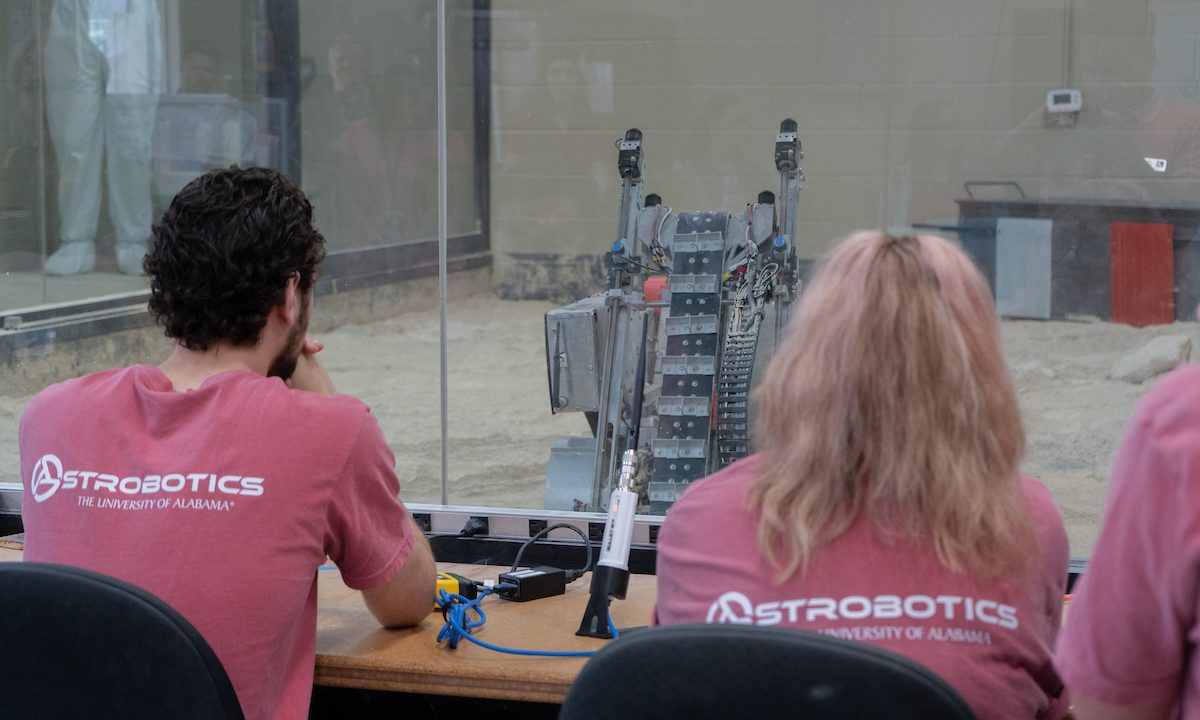A team of students from The University of Alabama once again shined at a national robotics mining competition, building upon a legacy of excellence and innovation.
Alabama Astrobotics claimed first place in one of only two categories awarded at the recent Robotic Mining Challenge, hosted by the UA College of Engineering and sponsored by Caterpillar Inc. UA’s team won the autonomy award after demonstrating more autonomous control throughout the competition than any other team.
“This team has a lot to be proud of,” said Dr. Kenneth Ricks, Alabama Astrobotics faculty advisor and interim department head for electrical and computer engineering. “They worked very hard and demonstrated the most functionally capable robot in the competition. They built a good robot in addition to being hosts for the entire competition.”
The event drew 22 collegiate teams to the UA campus May 22-26. The contest was designed to create solutions to problems faced on moon exploration missions. Each team spent the past year designing and building a robot that uses resources available on the lunar surface. During the competition, robots must autonomously navigate a lunar-simulated arena and excavate lunar soil, or regolith.
Throughout the week, teams took one 15-minute practice run and two competition runs in Alabama Astrobotics’ state-of-the-art lab that houses a pit with simulated lunar soil.
“The week was a big success,” Ricks said. “Teams from all over the country participated, and UA was able to show off our awesome facilities. There were several strong robots in the competition, and every team deserves congratulations for competing.”
Alabama Astrobotics entered the competition as a dynasty in robotic mining contests after placing first in the NASA Robotic Mining Competition: Lunabotics 2022. The team, comprised of about 70 students, has placed first eight times in previous NASA competitions. This year’s contest, though, was separate from the NASA contest typically hosted at Kennedy Space Center.
Judges of the competition included industry professionals from Caterpillar, the Exolith Lab at the University of Central Florida and NASA’s Solar System Exploration Research Virtual Institute. Since UA had a team participating in the challenge, the University had no part in establishing the competition rules or judging.
Additional sponsors of the event included Visit Tuscaloosa, Honda, Aerojet Rocketdyne, Florida Space Institute, Alabama Space Grant Consortium, i3, Cintas and 3M.
“This team has a lot to be proud of. They worked very hard and demonstrated the most functionally capable robot in the competition.
Dr. Kenneth Ricks
The competition concluded with a banquet and awards ceremony at the Bryant Conference Center. The top-performing teams were recognized with first through sixth place autonomy awards and first through third place mining awards. With UA coming out on top in autonomy, the team from Iowa State University placed first in the mining category.
Alabama Astrobotics is made up of students from engineering, computer science and other areas across campus who work throughout the academic year to design, build and program a robot while also leading outreach activities. The students get hands-on experience while learning to work on a larger project.
Students on the team often use their experience as a springboard to internships and jobs with companies connected to the contest and other companies connected to the space industry.
